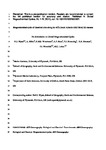Biogeochemical cycling of dissolved zinc along the GEOTRACES South Atlantic transect GA10 at 40°S
| dc.contributor.author | Wyatt, NJ | |
| dc.contributor.author | Milne, A | |
| dc.contributor.author | Woodward, EMS | |
| dc.contributor.author | Rees, AP | |
| dc.contributor.author | Browning, TJ | |
| dc.contributor.author | Bouman, HA | |
| dc.contributor.author | Worsfold, PJ | |
| dc.contributor.author | Lohan, MC | |
| dc.date.accessioned | 2016-02-22T11:52:38Z | |
| dc.date.available | 2016-02-22T11:52:38Z | |
| dc.date.issued | 2014-01-02 | |
| dc.identifier.issn | 0886-6236 | |
| dc.identifier.issn | 1944-9224 | |
| dc.identifier.uri | http://hdl.handle.net/10026.1/4354 | |
| dc.description | NERC NE/H004475/1 | |
| dc.description.abstract |
<jats:title>Abstract</jats:title><jats:p>The biogeochemical cycle of zinc (Zn) in the South Atlantic, at 40°S, was investigated as part of the UK GEOTRACES program. To date there is little understanding of the supply of Zn, an essential requirement for phytoplankton growth, to this highly productive region. Vertical Zn profiles displayed nutrient‐like distributions with distinct gradients associated with the water masses present. Surface Zn concentrations are among the lowest reported for the world's oceans (< 50 pM). A strong Zn‐Si linear relationship was observed (Zn (nM) = 0.065 Si (μM), <jats:italic>r</jats:italic><jats:sup>2</jats:sup> = 0.97, <jats:italic>n</jats:italic> = 460). Our results suggest that the use of a global Zn‐Si relationship would lead to an underestimation of dissolved Zn in deeper waters of the South Atlantic. By utilizing Si* and a new tracer Zn* our data indicate that the preferential removal of Zn in the Southern Ocean prevented a direct return path for dissolved Zn to the surface waters of the South Atlantic at 40°S and potentially the thermocline waters of the South Atlantic subtropical gyre. The importance of Zn for phytoplankton growth was evaluated using the Zn‐soluble reactive phosphorus (SRP) relationship. We hypothesize that the low Zn concentrations in the South Atlantic may select for phytoplankton cells with a lower Zn requirement. In addition, a much deeper kink at ~ 500m in the Zn:SRP ratio was observed compared to other oceanic regions.</jats:p> | |
| dc.format.extent | 44-56 | |
| dc.language | en | |
| dc.language.iso | en | |
| dc.publisher | American Geophysical Union (AGU) | |
| dc.subject | Zinc | |
| dc.subject | Biogeochemistry | |
| dc.subject | South Atlantic | |
| dc.subject | Chemical oceanography | |
| dc.subject | GEOTRACES | |
| dc.title | Biogeochemical cycling of dissolved zinc along the GEOTRACES South Atlantic transect GA10 at 40°S | |
| dc.type | journal-article | |
| dc.type | Article | |
| plymouth.author-url | https://www.webofscience.com/api/gateway?GWVersion=2&SrcApp=PARTNER_APP&SrcAuth=LinksAMR&KeyUT=WOS:000332972800004&DestLinkType=FullRecord&DestApp=ALL_WOS&UsrCustomerID=11bb513d99f797142bcfeffcc58ea008 | |
| plymouth.issue | 1 | |
| plymouth.volume | 28 | |
| plymouth.publication-status | Published | |
| plymouth.journal | GLOBAL BIOGEOCHEMICAL CYCLES | |
| dc.identifier.doi | 10.1002/2013GB004637 | |
| plymouth.organisational-group | /Plymouth | |
| plymouth.organisational-group | /Plymouth/Faculty of Science and Engineering | |
| plymouth.organisational-group | /Plymouth/Faculty of Science and Engineering/School of Geography, Earth and Environmental Sciences | |
| plymouth.organisational-group | /Plymouth/REF 2021 Researchers by UoA | |
| plymouth.organisational-group | /Plymouth/REF 2021 Researchers by UoA/UoA07 Earth Systems and Environmental Sciences | |
| plymouth.organisational-group | /Plymouth/Research Groups | |
| plymouth.organisational-group | /Plymouth/Research Groups/BEACh | |
| plymouth.organisational-group | /Plymouth/Research Groups/Marine Institute | |
| plymouth.organisational-group | /Plymouth/Users by role | |
| plymouth.organisational-group | /Plymouth/Users by role/Academics | |
| dcterms.dateAccepted | 2013-12-20 | |
| dc.rights.embargodate | 2015-1-2 | |
| dc.identifier.eissn | 1944-9224 | |
| dc.rights.embargoperiod | Not known | |
| rioxxterms.versionofrecord | 10.1002/2013GB004637 | |
| rioxxterms.licenseref.uri | http://www.rioxx.net/licenses/all-rights-reserved | |
| rioxxterms.licenseref.startdate | 2014-01-02 | |
| rioxxterms.type | Journal Article/Review |


